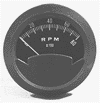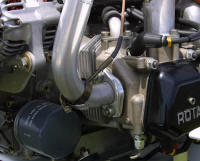|
In the early days of
ultralight aviation we used whatever we could find (or afford) to
get ourselves into the air. In many cases our primitive craft were
powered by a Mac 101 go cart engine, the 100 cc Yamaha go cart
engine, two Chrysler West Bend engines belted together, or
modified Pioneer chainsaw engines. The monetary investment in
these engines could range from nothing, to several hundred
dollars, and we generally got what we paid for!
With little money tied up
in the engines, it didn't make any sense to spend hundreds of
dollars in engine instruments to monitor them. We new they were
going to quit we just didn't know when!
Today even the cheapest engine starts at over $2,000 and can run
upwards of $20,000. When you consider the craft they are installed
in might cost another $20,000 plus the time and effort required to
built it , it makes common sense to spend a little money to watch
over our investment. Some of these instruments are required to
insure proper performance, others are used to tune the engine,
while others are used watch for engine problems such as
overheating. Lets look at some of the instruments that should be
found on most two and four stroke Rotax engines. (Remember a two
stroke is a two stroke, and a four stroke a four stroke, no matter
who the manufacturer is, thus this basic information can be used
for other engines.
Tachometer

The tachometer plays a very important role in engine
ensuring proper engine cooling and performance. An engine allowed
to over rev will run a lean fuel and can result in engine
overheating and possibly engine failure due to seizure. If the engine is not allowed to rev up to its
proper RPM this can cause engine overheating, or engine failure
due to the engine not being able to burn the fuel they way it was
designed to. A pilot taking off on an engine that can only develop
5900 RPM can attest to the fact that his engine will loose power
and eventually quit. So what role does the tachometer play in all
this? The
tachometer is used to properly pitch the propeller, and a properly
pitched prop means the engine will, if everything else is correct,
provide the best climb, cruise and engine performance available.
To achieve this you most
know what engine RPM your engine was designed to do in straight
and level flight under full power application. Since you can't do
this safely in the air, you must do it on the ground, with the
craft tied down. There is one other problem since the craft moving
through the air is provide clean air entering the prop at whatever
speed you are doing, and a plane tied down only has the advantage
of clean air into it, you must allow for this when setting the
propeller.
Example:
A 503 and or 582 Rotax twin carbed two stroke engine
should rev up to 6500 RPM in straight and level flight under full
power. Experience has shown that this can be achieved if the craft
is tied to the ground and the prop is set so that under full power
the engine can only pull about 6200 to 6300 RPM. This should give
you 6500 in the air. Since all Rotax engines are supplied with a
break in procedure and it is required that it be done before the
engine is put into service, the first time you will use your
tachometer is to set the pitch on your prop for the break in. An
engine that is allowed to pull 7200 RPM tied down on the ground is
not likely to make it through the whole break in procedure,
without seizing up!
Just as an engine that is set for 5500 RPM will start to loose
power and RPM after about 10 minutes.
For more information click here.
Exhaust Gas
Temperature Gauge (EGT)

The next gauge that should be on all Rotax engines is
an EGT, and you should have a separate gauge and lead for each
cylinder! You can't just stick a probe in the center of the "Y"
pipe and expect to get a proper reading. New Rotax exhaust
manifolds provide a spot to install the probes. On older systems
it is necessary to measure out from the PISTON, 100 mm and then
drill a hole in center of the "Y" pipe on each side.
According to the factory exhaust gasses exiting the engine are the
hottest on Rotax engines at this distance. (Picture a flame from a
propane torch, it is hottest at the end of dark blue flame.) When
routing the probes do not "COIL" them up try to run them as
straight as possible without overlapping them.
An exhaust gas temperature gauge can show you whether your engine
combustion chamber is running to hot or cold, lean or rich. It can
also indicate problems with the engine.
For example:
-if your intake manifold were to develop a crack this
could cause a lean fuel mixture, which would result in a higher
EGT on that side.
-if the needle in the throat of the carb were to wear and drop
down a notch this would show up on your EGT.
-if your gas to oil mixture was wrong it would show up quickly on
the EGT.
-if something was wrong with your ignition system, a bad spark
plug or faulty ignition cap/coil/wire this would show up as a
colder EGT reading, since the fuel isn't being burned properly.
-if your prop is not set correctly it will show up in your EGT
temps
-if a problem develops in one carb due too much or too little fuel
this will show up in the EGT prior to take off it is very
important that the engine be brought up to operating temperature,
1000 to 1200 degrees F you use EGT gauges to do this.
The proper EGT reading for all two stroke Rotax engines is 1,000
to 1,200 degrees F.
Click here for EGT gauges
and pricing.
For more information click here.
For Ducati ignition click here.
|
|
Ultralight Aircraft News Web Magazine EMAIL for l Information.
No part of this
publication may be copied or distributed, transmitted, transcribed,
stored in a retrieval system, or translated into any human or computer
language, in any form or by any means, electronic, mechanical,
manual, or otherwise, without written permission of Ultralight Aircraft News.
By copying or paraphrasing the intellectual
property on this site, you're automatically signing a binding contract
and agreeing to be billed $10,000 payable immediately. Copyright Ultralight News |

